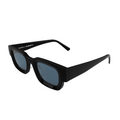Do Your Prescription Inserts for Sports Sunglasses Really Need an Anti-Reflective Coating?
For athletes and outdoor enthusiasts who require vision correction, sports sunglasses with prescription inserts are a game-changer. They offer the specialized, high-wrap protection of performance eyewear with the sharp vision you rely on. But a common question we hear at PandaOptical is this: "If my main sunglasses are already polarized or have an anti-reflective (AR) coating, do I really need to spend extra for an AR coating on the inner prescription lenses?"
The short answer is a resounding yes. While it might seem like an unnecessary add-on, investing in an AR coating for your prescription inserts is one of the most important upgrades you can make for your visual comfort and performance. Here’s why.
The Core Job of an Anti-Reflective (AR) Coating
First, let's quickly recap what an AR coating does. Its primary function is to minimize the light that reflects off the surfaces of your lenses. By doing so, it allows more light to pass directly through to your eyes. This results in:
Sharper, clearer vision
Reduced eye strain
Elimination of distracting glare and "ghost images"
Why the Outer Sunglass Lens Can't Do It All
Even the most advanced outer lenses can't prevent reflections that happen closer to your eye. When you use a prescription insert, you create a multi-lens system, and that's where two key problems arise.
Problem 1: Back-Surface Glare
This is the biggest and most distracting issue. Light, especially light coming from your sides or from behind you, can pass through the outer sunglass lens, then through your inner prescription lens, and reflect off the back surface of that inner lens directly into your eye.
This creates a clear, annoying reflection of your own eye, your cheek, or whatever is behind you. It’s a constant distraction that can reduce focus and cause significant eye fatigue. No coating on the outer lens can stop this from happening. Only an AR coating on the back of your prescription insert can neutralize this reflection.
Problem 2: The "Bounce" Between Lenses
In the small air gap between your outer sunglass lens and your inner prescription insert, light can get trapped. It bounces back and forth between the two surfaces, creating faint, secondary "ghost images." This internal reflection reduces visual contrast and clarity, which can be critical when you need to judge terrain or track a fast-moving object. An AR coating on your prescription insert minimizes this internal bounce, ensuring a single, crisp image.

A Quick Word: Polarization vs. Anti-Reflective Coatings
It’s important not to confuse these two technologies. They solve different problems.
Polarization is a filter that eliminates blinding glare reflected off horizontal surfaces like water, pavement, or snow. It's fantastic for visual comfort in sunny conditions.
An Anti-Reflective Coating eliminates the reflections created by the lens surfaces themselves.
A polarized outer lens is excellent, but it does nothing to stop the back-surface glare or internal reflections created by your prescription insert.
The PandaOptical Recommendation
At PandaOptical, our goal is to provide our customers with the best possible vision. That's why we strongly recommend that you always opt for an anti-reflective coating on the prescription lenses for your sports inserts.
Think of it not as an extra but as an essential component for completing your performance eyewear system. The enhanced clarity, safety, and comfort you'll experience are a crucial investment in your athletic performance and overall enjoyment of your sport.

Don't let distracting reflections hold you back. When customizing your next pair of sports sunglasses, be sure to include an AR coating on your inserts. If you have any more questions, our team of optical experts is always here to help!





